Innovating Innovation
The Future of Competition
by C.K. Prahalad and Nekat Ramaswamy.
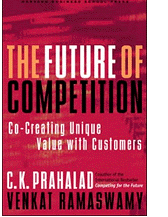
In his new book, The Future of Competition, C. K. Prahalad states: “Managers can no longer focus solely on costs, product and process quality, speed , and efficiency. For profitable growth, managers must also strive for new sources of innovation and creativity.”
“In our networked economy the power of an individual mind is unleashed, information is no longer limited to large corporations with major research departments. State-of-the-art information on any subject can be gathered by anyone from almost anywhere that high-speed internet connectivity exists.
Sharing among consumers confirms common benefits that resonate universally and embolden consumer inventors to take their ideas to the next level.”
“The shift in power from businesses that determine what customers need and then manipulate demand to meet their offerings; to networks of customers and producers who jointly create value may be the defining shift in market structure in the first part of the twenty-first century.”
Juice, The Creative Fuel That Drives World-Class Inventors By Evan I. Schwartz
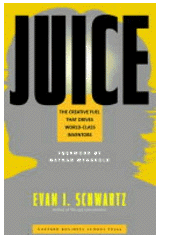
“Invention is the ultimate source of all that’s new. Every gizmo, gadget, technique, or tool was born in a flash of inspiration in somebody’s head at some point in time. Invention is to technology what conception is to reproduction —the moment that makes something original and unprecedented. As such, it is the highest-vale activity that any individual or company can engage in.”
“The history of our world is, to a large extent, the history of inventions. Some inventions were small incremental improvements, while others were radical and transformative breakthroughs. James Watt’s steam engine powered the industrial revolution.
The nineteenth century saw advances such as the internal combustion engine, steel production, railroads, the telegraph and the telephone, photography and cinema, the elevator, incandescent lighting, electric motors, and the power grid. The twentieth century was driven by the automobile and the airplane, radio and television, atomic energy, electronics, and the digital computer.”
“We may not know exactly which inventions from the worlds of biotech. medical devices and nanotech will shape the twenty-first century, but we cannot doubt that there will be such inventions. Our world is no longer just inherited from nature —it is an invented world.”
“Despite the incredible impact of invention, it is given short shrift in many circles. Engineering tends to focus on the subsequent development, refinement and deployment of an idea, paying relatively little attention to invention itself. In the process, something strange has happened. The attention given to implementing and marketing inventions has, in most organizations, eclipsed invention itself. … There isn’t a manual or textbook for invention, but you can get insights into the process”.
Unleashing the Ideavirus
by Seth Godin, Malcolm Gladwell
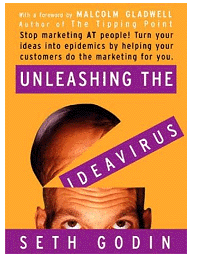
“Fact is the first 100 years of our country’s history were about who could build the biggest, most efficient farm. And the second century focused on the race to build factories. Welcome to the third century folks. The third century is about ideas.”
“Alas, nobody has a clue how to build a farm for ideas, or even a factory for ideas. We recognized that ideas are driving the economy, ideas are making people rich and most important, ideas are changing the world. Even though we are clueless about how to best organize the production of ideas: if you can get people to accept, embrace, adore and cherish your ideas, you win.
The holy grail for anyone who traffics in ideas is this: to unleash an ideavirus. An idea that just sits there is worthless. But an idea that moves and grows and infects everyone it touches… that’s an ideavirus. We’re all obsessed with ideas because ideas, not products, are the engine of our new economy.”
Crossing the Quality Chasm:
A New Health System for the 21st Century
The Institute of Medicine -Committee on Quality of Health Care in America
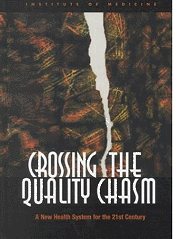
Health care today is characterized by more to know, more to manage, more to watch, more to do, and more people involved in doing it than at any time in the nation’s history. Our current methods of organizing and delivering care are unable to meet the expectations of well informed patients and their families because the science and technologies involved in health care —the knowledge, skills, care interventions, devices, and drugs —have all advanced more rapidly than our systematic ability to deliver them safely, effectively, and efficiently. The gaps need to be addressed with comprehensive solutions combining multiple disciplines and innovation best practices.
The Tipping Point: How Little Things Can Make a Big Difference
by Malcolm Gladwell
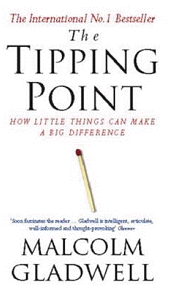
“In this brilliant and groundbreaking book, New York writer Malcom Gladwell looks at why major changes in our society so often happen suddenly and unexpectedly. Ideas, behavior, messages and products, he argues, often spread like outbreaks of infectious disease. Just a single sick person can start an epidemic of the flu, so too can a few fare-beaters and graffiti artists fuel a subway crime wave, or a satisfied customer fill the empty tables of a new restaurant.
These are social epidemics, and the moment when they take off, when they reach their critical mass, is the Tipping Piont. He explores new concepts that govern social phenomena like: The Three Rules of Epidemics, The Law of the Few: Connectors, Mavens, and Salesmen and The Stickiness Factor.”
